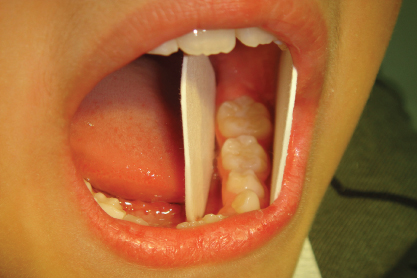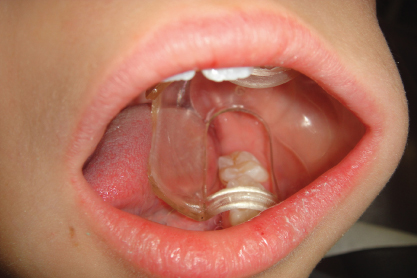Chapter 9
Sealants
Jane A. Soxman and Patrice B. Wunsch
According to the 2014 AAPD Guidelines, pit and fissure caries account for 80 to 90 percent of all caries in the permanent teeth and of 44 percent of all caries in the primary teeth. (American Academy of Pediatric Dentistry, 2014). The teeth at highest risk by far are the permanent first and second molars where fluoride has its least preventive effect on the pits and fissures. In children aged 5–17 years, 67–90% of caries occurs on occlusal surface of molars. The eruption time for first and second permanent molars is 1.5 years, but premolars take only 1–2 months (Antonson et al., 2012). With consideration of all of these factors, sealants provide the best method to prevent occlusal caries in young permanent molars. Sealants on the occlusal surfaces of primary molars are retained at a rate of 74.0–96.3% at 1 year and 70.6–76.5% at 2.8 years (Table 9.1; Beauchamp et al., 2008).
Table 9.1 AAPD recommendations for sealant placement (American Academy of Pediatric Dentistry, 2014)
| Sealants should be placed into pits and fissures of teeth based on the patient’s caries risk and not the patient’s age or time elapsed since tooth eruption |
| Sealants should be placed on surfaces judged to be at high risk or surfaces that already exhibit incipient carious lesions to inhibit lesion progression. Follow-up care, as with all dental treatment, is recommended |
| Sealant placement methods should include careful cleaning of the pits and fissures without removal of any appreciable enamel. Some circumstances may indicate use of a minimal enameloplasty |
| A low-viscosity hydrophilic material bonding layer, as part of or under the actual sealant, is recommended for long-term retention and effectiveness |
| Glass ionomer materials could be used as transitional sealants |
Source: American Academy of Pediatric Dentistry (2014). Reproduced with permission of American Academy of Pediatric Dentistry.
Permanent molars are highly porous at eruption and susceptible to caries. Complete maturation of the enamel does not occur until 62 months after eruption. Placing a sealant as soon as the tooth can be adequately isolated is highly efficacious in reducing the incidence of pit and fissure caries (Kataoka et al., 2007). The risk for caries is the highest during the first few years after eruption.
When restoring the primary dentition, consideration may be given to sealing the occlusal surfaces of the primary molars in the high-caries risk child. This may be a good-will gesture, as insurance may not cover this procedure, but reduces and protects the occlusal surfaces for future colonization of mutans streptococcus.
Caries detection
Forceful probing of occlusal surfaces with an explorer pierces immature, porous enamel, creating enamel defects and possibly converting incipient caries to frank cavitation (Kuhnisch et al., 2007). An explorer may be gently run through the fissures to check for any changes or breaks in the enamel surface followed by forcefully rinsing with water to remove plaque and debris. Sealant integrity and retention can also be evaluated with the explorer (Margherita et al., 2010). Strassler et al. (2005) found laser fluorescence to be 90% accurate for caries detection. Laser fluorescence caries detection devices use a laser light to scan below the enamel surface detecting demineralized tooth structure. Prophylaxis pastes with blue or green dye produce an inaccurate reading. Staff can be taught to use the device, saving time for the dentist.
Moisture control
Inadequate moisture control is the primary reason for sealant loss. Resin-based sealants are hydrophobic and require isolation that assures no salivary contamination. Isolation may be accomplished with a rubber dam, cotton rolls ligated with dental floss, dri-aides/dry angles, Parkell dry-field mouth prop, the Isolite or Isodry, or the Blue Boa (Figures 9.1–9.4a, and 9.4b). With difficulty in moisture control, the Adper Prompt L-Pop (3M-ESPE), a self-etch adhesive, provides improved bonding. Fluoride varnish may also offer a moisture-tolerant alternative for a patient with a strong gag reflex or inability to cooperate for placement of glass ionomer or sealant but requires more frequent application.

Figure 9.1 Dri-angles.

Figure 9.2 Parkell dry-field mouth prop.
Stay updated, free dental videos. Join our Telegram channel

VIDEdental - Online dental courses


